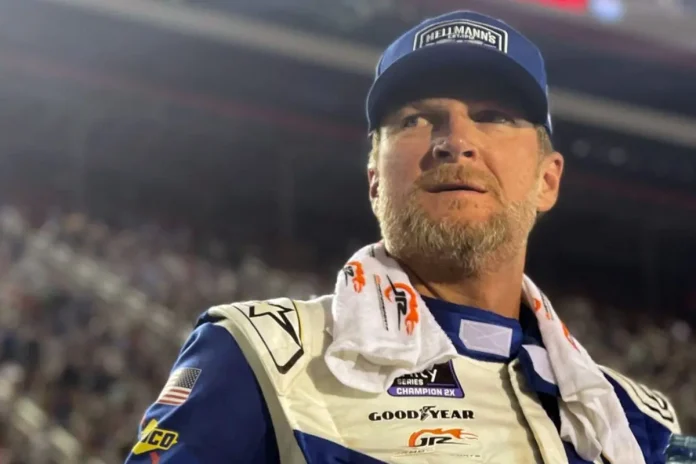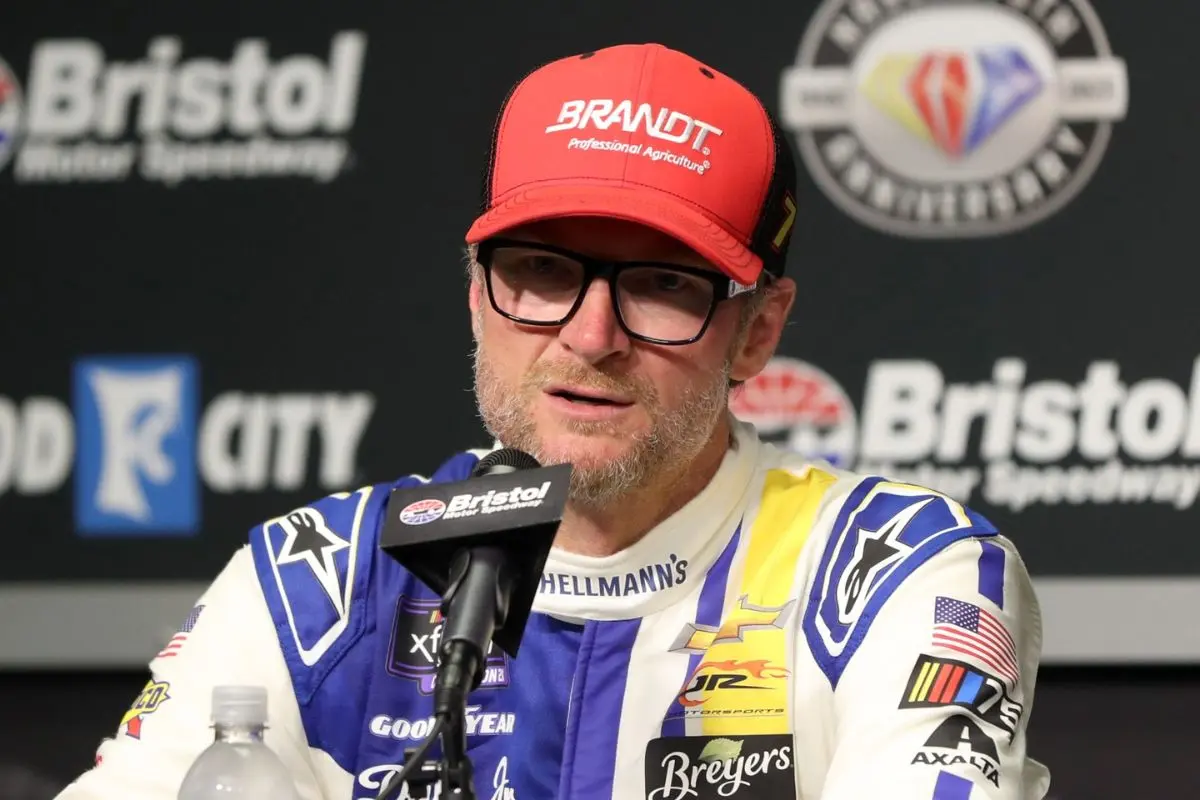Dale Earnhardt Jr.’s Critical Remarks on Phoenix Raceway: Dale Earnhardt Jr. has voiced strong criticism of the dogleg design at Phoenix Raceway, calling it a dangerous and foolish feature. His concerns grew after recent safety incidents, particularly following Ty Gibbs’ crash, which highlighted the inherent risks of the sharp angles and sudden shifts within this track section. Earnhardt Jr. argues that the aggressive racing tactics employed today do not align with the original design intent, potentially compromising driver safety and the integrity of the sport. Ongoing discussions around track safety are critical, suggesting that further insights into the implications of these design flaws are necessary.
Key Highlights
- Dale Earnhardt Jr. criticizes the dogleg design at Phoenix Raceway as “foolish and silly,” citing safety concerns for drivers driving its sharp angles.
- The dogleg’s abrupt shifts increase physical strain on drivers, leading to discomfort and potential long-term injuries, especially with Next-Gen cars.
- Earnhardt Jr. emphasizes the need for continuous evaluation of track designs to prioritize driver safety and maintain the integrity of racing.
- Following Ty Gibbs’ crash, discussions about the dangers of the dogleg have intensified, highlighting the urgent need for safety improvements in NASCAR.
- Earnhardt Jr. advocates for rotating the championship finale location, suggesting that diverse racing scenarios could enhance viewer engagement and safety awareness.
Dale Earnhardt Jr. Critiques Phoenix Raceway’s Safety
Dale Earnhardt Jr. has raised considerable concerns regarding the safety of Phoenix Raceway, particularly its controversial dogleg section. This critique emerges in the wake of a harrowing crash involving driver Ty Gibbs, which has reignited discussions on track safety within the NASCAR community.
Earnhardt Jr., a seasoned veteran who retired early due to the long-term effects of concussions, possesses a unique perspective on the physical demands of racing, making his insights particularly compelling.
In his recent podcast episode, he articulated his concerns about the dogleg’s design, emphasizing that it poses considerable risks to drivers. The sharp angles and abrupt shifts inherent in this section of the track not only challenge drivers’ skill and precision but also exacerbate the physical toll on their bodies.
Earnhardt Jr. has argued that the dogleg does not represent the pinnacle of track engineering, suggesting that its layout could potentially compromise driver safety.
The broader implications of such critiques are significant, as they signal a growing recognition within the sport of the need for continuous evaluation and improvement of track designs.
The Dogleg is Foolish: Dale Jr. Sounds Off
In a straightforward assessment of Phoenix Raceway‘s controversial dogleg, Dale Earnhardt Jr. has expressed strong disapproval, labeling it as “foolish and silly.” His critique centers on the unintended consequences of the track’s design, particularly how drivers have adapted to aggressively cut across this section during restarts to gain a competitive advantage.
Dale Jr. articulates that the dogleg was never intended to be utilized in the manner observed today, raising concerns about the integrity of the racing experience. The former driver emphasizes that the design’s implications were not fully considered during its engineering. He posits that if the creators intended for the dogleg to facilitate such aggressive tactics on restarts, it would warrant a different discussion.
“So there’s there’s a bunch of reasons why. But again, in general, Phoenix is, look, the old track with the older surface, I like that better, but it raced about the same. The dogleg is foolish and silly, as I thought it was when it came out, how they cut the course, uh, which is just at, you know, I don’t know.” – (Dale Earnhardt Jr.)
However, he firmly believes that they underestimated the racing dynamics that would emerge, leading to potential safety risks and a compromised racing philosophy. “I don’t love when you build a track, and the best way to run it is by cutting the course,” he remarked, highlighting his discontent with the design’s current execution.
Earnhardt Jr.’s insights resonate with a broader concern within the racing community regarding track design and its implications for driver strategy. The dogleg serves as a focal point in discussions about NASCAR’s commitment to maintaining a competitive yet safe environment.
“I don’t love when you build a track, and the best way to run it is by cutting the course. Uh, I don’t think when they built it—actually, I’ll say this—now if they built it intentionally for restarts to be that way, then I would go, all right. But I know damn well the guy who engineered that thing never knew what those restarts would be like. They thought they would be up there, not down on the dogleg.” – (Dale Earnhardt Jr.)
Concerns Over the Dogleg’s Physical Impact on Drivers
Multiple drivers have expressed growing concerns about the physical toll that Phoenix Raceway’s dogleg takes during races, particularly with the demanding setups of the Next-Gen cars. The design of the dogleg, with its abrupt shift and uneven surface, increases the strain on drivers as they drive the track at high speeds.
“I’ve talked to a lot of drivers as they go across that apron, and they hate to do it because it’s so violent and it’s hard on their head. It’s too rough on the drivers.” – (Dale Earnhardt Jr.)
Dale Earnhardt Jr. highlighted the issue, noting that many drivers dread crossing the apron due to its violent impact, which can lead to considerable discomfort and potential injury.
The recent crash involving Ty Gibbs further emphasized these concerns. Gibbs experienced a harrowing encounter with the wall, which he attributed to the challenging conditions of the dogleg. His admission that the impact felt more severe due to the track’s characteristics raises questions about driver safety and the adequacy of current safety measures.
“It was definitely a big hit. I made contact with the wall, but I didn’t think it was necessarily too bad, and I went off into the dogleg. We’ve been really hard on the track there all week, and I think I just caught it at a bad angle, and it just took off from me. I had no control there.” – (ty gibbs)
As drivers attempt to manage the aggressive setups of their cars, the abrupt jolt encountered while traversing the dogleg can be disorienting and physically taxing.
Is it Time for NASCAR to Relocate its Championship Finale?
The debate surrounding the location of NASCAR’s championship finale has intensified, with growing calls for a reassessment of Phoenix Raceway as the final stage for the season.
While the dogleg design has drawn considerable scrutiny, Dale Earnhardt Jr. has raised broader questions regarding the suitability of Phoenix as the championship venue. His remarks suggest that the excitement generated by the track can be inconsistent, with the potential for thrilling races overshadowed by the risk of dull outcomes.
Earnhardt Jr. acknowledged that while some races at Phoenix have been engaging, others have failed to captivate audiences. He pointed out that the variable nature of racing at Phoenix—where some events are exhilarating and others lack excitement—may warrant consideration for a more dynamic championship format.
“Hey, all I’m going to say is I think, you know, Phoenix is gonna be Phoenix. Sometimes going to be great races there, sometimes not so amazing, but last year Phoenix I thought was great. The one car holding off to 12 for the championship in the Cup Series that was entertaining to me. I was entertained. And so not, you know, not so much this year and that’s okay. Sometimes it’s going to have those.” – (Dale Earnhardt Jr.)
His endorsement for rotating the finale to different tracks highlights a desire for increased variety and unpredictability at the season’s peak. Such a change could not only improve viewer engagement but also allow for tracks with unique characteristics and challenges to host the championship.
“Let it play out. If it (Phoenix) ends up being a snooze fest, oh well. We have those sometimes. Should we race somewhere else for the end of the year? Yeah, we probably should move it around.” – (Dale Earnhardt Jr.)
This would provide drivers and teams with diverse racing scenarios, ultimately enriching NASCAR. The current trend of returning to Phoenix, while historically notable, may risk stagnation.
Dale Earnhardt Jr.’s Personal Connection to Safety Concerns
Dale Earnhardt Jr.’s demand for safety in NASCAR stems from deeply personal experiences that shape his perspective on the sport. Having retired in 2017 due to multiple concussions sustained from high-speed crashes, Dale Jr. understands the grave risks drivers face on the track. His departure from racing was not just a career change; it was a notable re-evaluation of his priorities and the importance of safety.
Moreover, the tragic loss of his father, Dale Earnhardt Sr., in a catastrophic accident at Daytona in 2001 adds a profound dimension to his commitment to driver safety. As a seven-time Cup Series champion, Dale Sr. personified excellence in racing, yet his fate serves as a striking reminder that no driver is invulnerable.
Dale Jr.’s insights are informed by personal loss and physical suffering, making his concerns particularly resonant. He emphasizes that safety cannot be compromised, regardless of the thrilling spectacle it may bring.
- The irreversible impact of concussions on a driver’s life and career.
- The necessity for NASCAR to prioritize driver welfare over entertainment value.
- The urgency of addressing design flaws in tracks that could lead to dangerous situations.
As he voices these concerns through his platform as a broadcaster and podcast host, the question remains: will NASCAR heed his calls for meaningful change, or will the sport continue to go through these challenges without recalibrating its approach to safety?
News in Brief: Dale Earnhardt Jr.’s Critical Remarks on Phoenix Raceway
Dale Earnhardt Jr.’s critique of the Phoenix Raceway’s dogleg design highlights notable safety concerns within NASCAR. The potential physical impact on drivers raises questions about the appropriateness of the current track layout, particularly for intense events such as the championship finale.
The ongoing dialogue regarding track safety emphasizes the necessity for continuous evaluation and potential redesigns to prioritize driver well-being and improve the general integrity of the sport.
ALSO READ: Dale Earnhardt Jr. Asks Fans for Help with NASCAR Game Development





